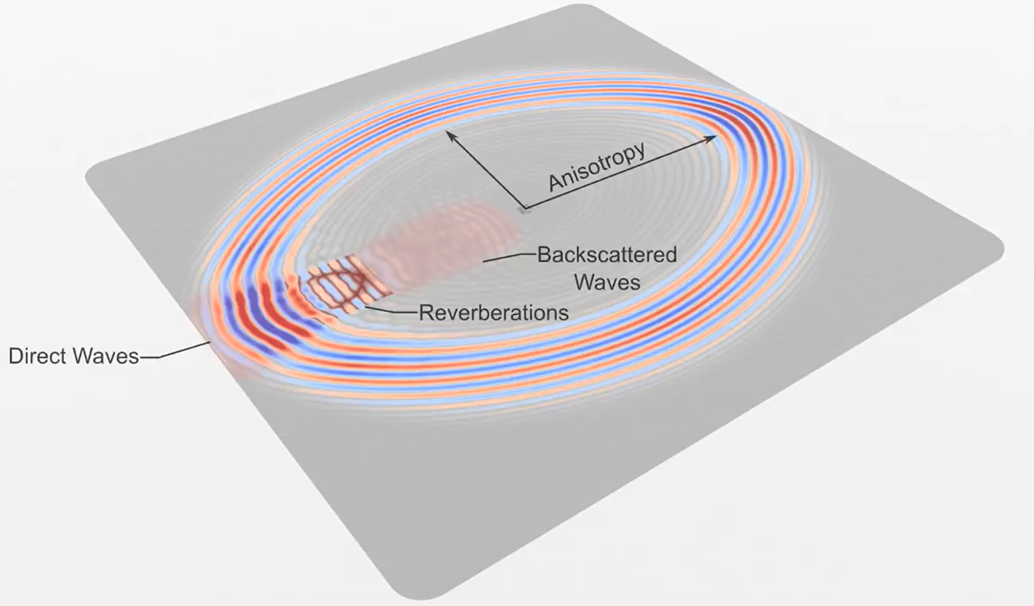Digital Twins for Non-Destructive Evaluation of Composite Materials with Ultrasound
An innovative new method for non-destructive ultrasonic testing of laminated composite materials.
- non-destructive testing
- simulation
- structural health monitoring
- composite materials
- aerospace
In the ever-evolving world of aerospace applications, the demand for strong, reliable, and lightweight materials continues to shape design and quality assurance processes. Moreover, the increasing need for long lifetimes and reusable components has driven the development of laminated carbon-fiber reinforced composites. These cutting-edge composite materials possess unique elastic properties and specific failure modes, such as delamination, which present challenges for conventional non-destructive ultrasonic inspection techniques in terms of time and sensitivity.
Recent advancements in seismic wave analysis, particularly the technique known as full-waveform inversion, have become the gold standard for creating high-resolution quantitative images of the subsurface. However, this method's potential application to ultrasonic non-destructive testing has remained largely unexplored, primarily due to computational limitations. With the recent rise in cloud computing capabilities, we now have the opportunity to leverage this innovative approach to detect certain types of damage or faults with higher sensitivity and specificity than ever before. Notably, ultrasound computed tomography has already gained momentum in the field of biomedical imaging, especially in breast cancer screening.
As a prerequisite to this exciting venture, our project aims to collect ultrasonic test data for laminated composite material specimens and create digital twins for further analysis. Specifically, our goal is to establish a proof-of-concept by replicating a benchmark specimen from the literature, performing multiple ultrasound measurements, and validating the acquired data through numerical simulations.
The success of this project will provide invaluable insights into the feasibility of this novel scanning technique. Mondaic, in collaboration with our research partners, plans to further develop this technology and bring it to the market within the next three years. This groundbreaking research will not only assess the sensitivity of ultrasound scans to delamination but also validate the reproducibility of the data in numerical simulations. The calibrated digital twins we create will be invaluable assets for fine-tuning Mondaic's imaging software to suit the specific failure modes of composite materials, generating realistic training data for machine-learning applications, and advancing research to enhance the sensitivity and specificity of the reconstruction algorithm.
Furthermore, the acquired data will enable us to design an initial acquisition protocol and optimize the transducer geometry, essential steps in providing more accurate cost estimates for the required scanning hardware and computational resources.
Our journey into the realm of ultrasonic non-destructive testing of composite materials promises groundbreaking advancements in the field. Here's an overview of our progress:
1) Fabricating the Specimen
For this feasibility study, we crafted a specimen with a setup similar to those described in existing literature. The plate measures 270 mm x 270 mm and consists of a cross-ply layup of [02/902]s using 8 plies of HexPly® 8552/AS4. A 30 mm x 30 mm Teflon patch was inserted in the left half of the plate, between the 90 and 0 plies or we use a impact device shown in the next figure.
2) Lab Experiments with Ultrasound
Our experiments took place at the WaveLab, run by the Exploration and Environmental Geophysics group at ETH Zurich. We took extensive measures to ensure accurate measurements, including clamping edges to minimize reflections, and using robotized 3D scanning laser Doppler vibrometer for precise measurements. Several emitters were tested, and we found that a dominant frequency of 100 kHz offered the best signal-to-noise ratio. Beside we are using conventional ultrasonic devices available at the FHNW to compare the measurements.
3) Digital Twin Modelling
To synthetically recreate the experimental setup, we employed Mondaic's Salvus software. The computational domain was subdivided into hexahedral finite elements, with the time step chosen to meet the Courant-Friedrichs-Lewy condition. We opted for a meshing strategy that captured the effective medium properties, thus reducing computational costs. Material properties, source characteristics, and simulation results are presented in detail.
4) Summary and Outlook
This first feasibility study marks the beginning of an exciting journey towards more advanced ultrasonic non-destructive testing and will be further developed in a running funded project supported by the Innosuisse. The calibrated digital twin we've created opens the door to numerous potential studies, including sensitivity analysis, optimal experimental design, and parameter estimation. These avenues of research will help us bring this technology into practice and pave the way for a more advanced and efficient approach to non-destructive testing.
Client | |
Execution | |
Duration | 2 years |
Funding |


